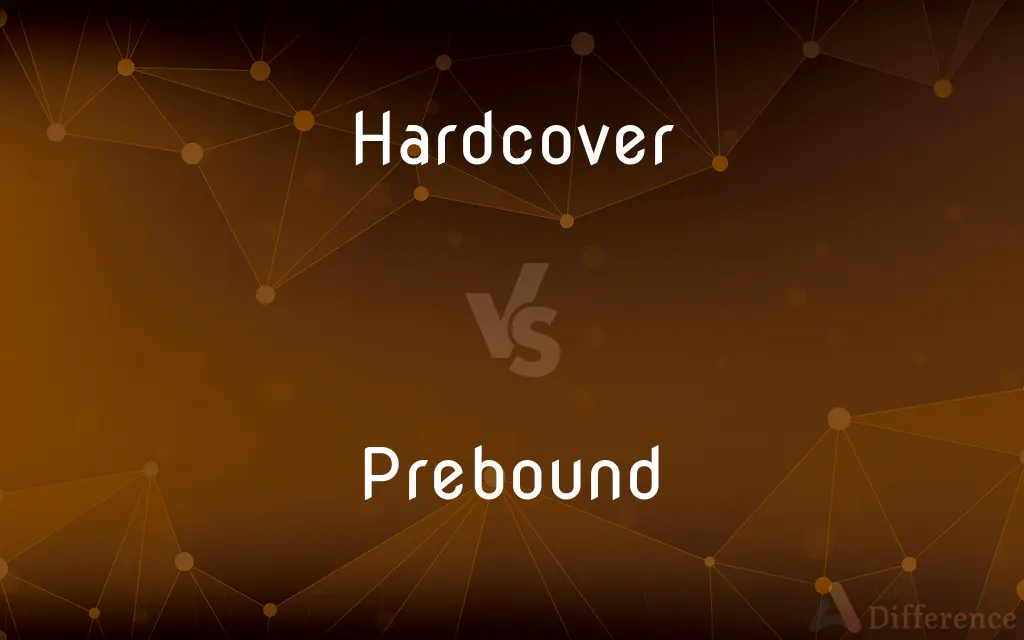Hardcover vs. Prebound — What's the Difference?
By Fiza Rafique & Urooj Arif — Updated on March 14, 2024
Hardcover books are traditionally bound with rigid protective covers, while prebound books are originally softcovers reinforced for durability, often for library use.

Difference Between Hardcover and Prebound
Table of Contents
ADVERTISEMENT
Key Differences
Hardcover books are known for their durability and aesthetic appeal, featuring thick, rigid covers made of cardboard covered in cloth or paper. They are often the first edition to be released by publishers, aimed at collectors and readers who value longevity and quality. Prebound books, on the other hand, start as paperback or softcover editions and are then rebound with a durable hardcover by a third-party company, mainly to withstand frequent handling and circulation, making them a common sight in libraries and schools.
The binding process for hardcovers involves assembling the book's signatures, attaching them to the spine of the cover, and often including additional protective features like dust jackets. Prebound books take an existing softcover book, remove its original cover, and then attach a new, sturdy hardcover using library-grade materials. This process enhances the book's resistance to wear and tear but does not alter its original interior content.
One key difference between hardcover and prebound books is their market focus. Hardcover editions are targeted towards a general audience, including collectors and those preferring quality and durability for personal libraries. Prebound editions are specifically aimed at institutions like libraries and schools that require books to last through multiple readings and lendings, emphasizing durability over aesthetic considerations.
In terms of cost, hardcover books are typically more expensive than their paperback counterparts due to the materials and process involved in their creation. Prebound books, while also more costly than standard paperbacks, offer a cost-effective solution for institutions needing durable books, as they extend the life of less expensive softcover editions.
Despite the differences, both hardcover and prebound books serve the purpose of providing readers with long-lasting editions. Hardcover books cater to those who appreciate the tactile and visual qualities of a well-made book, while prebound books address the needs of institutions requiring books that endure frequent use.
ADVERTISEMENT
Comparison Chart
Material
Rigid covers, often cloth or paper
Reinforced covers for durability
Original Edition
First edition release
Rebinding of paperback editions
Target Audience
General readers, collectors
Libraries, schools
Durability
Durable, designed for longevity
Enhanced durability for heavy use
Cost
More expensive than paperbacks
Cost-effective for institutional use
Compare with Definitions
Hardcover
First to market.
Bestsellers are typically released as hardcovers before any other format.
Prebound
Cost-efficiency.
Prebinding offers a durable solution without the higher cost of original hardcovers.
Hardcover
Traditional binding.
Classic novels are often published in hardcover editions for their collectible value.
Prebound
Library-grade reinforcement.
Popular paperback titles are prebound for added durability in libraries.
Hardcover
Rigid, protective cover.
The hardcover book's sturdy design protects its pages from damage.
Prebound
Conversion process.
Softcover books are transformed into prebound editions with strong, durable covers.
Hardcover
Collector's choice.
Collectors prefer hardcover editions for their durability and display qualities.
Prebound
Focus on longevity.
Prebound books are designed to withstand repeated borrowings and use.
Hardcover
Aesthetic appeal.
Hardcover books often feature decorative dust jackets and embossed titles.
Prebound
Institutionally targeted.
Schools often purchase prebound editions of textbooks for student use.
Hardcover
Having a rigid binding, as of cardboard covered with cloth or with leather. Used of books.
Prebound
A prebound book is a book that was previously bound and has been rebound with a library quality hardcover binding. In almost all commercial cases, the book in question began as a paperback version.
Hardcover
A hardcover, hard cover, or hardback (also known as hardbound, and sometimes as case-bound) book is one bound with rigid protective covers (typically of binder's board or heavy paperboard covered with buckram or other cloth, heavy paper, or occasionally leather). It has a flexible, sewn spine which allows the book to lie flat on a surface when opened.
Prebound
Of a book: rebound with a library quality hardcover binding. In almost all commercial cases, the book in question began as a paperback.
Hardcover
(of a book) bound in stiff covers; hardback
Hardcover and paperback editions
Hardcover
A book bound in stiff covers; a hardback.
Hardcover
A hardcover book.
Hardcover
A book with a rigid binding, often of cardboard or leather.
Hardcover
(of a book) Having a rigid binding.
Hardcover
A book with cardboard or cloth or leather covers
Hardcover
Having a hard back or cover;
Hardback books
Common Curiosities
Can prebound books be purchased by individuals?
While aimed at institutions, individuals can purchase prebound books, especially for high-use titles.
Why choose hardcover over prebound?
Choose hardcover for personal collections and aesthetic value, and prebound for institutional use requiring durability.
What makes a book prebound?
A prebound book is a paperback or softcover that has been rebound with a hardcover by a third-party for added durability.
Are prebound books more expensive than original paperbacks?
Yes, due to the additional process of reinforcing them, but they are cost-effective for frequent use environments like libraries.
What is the main advantage of hardcover books?
The main advantage is their durability and aesthetic appeal, making them desirable for collectors and readers.
How do libraries benefit from prebound books?
Libraries benefit from the extended lifespan and durability of prebound books, ensuring titles remain in circulation longer.
Are hardcover books better for the environment?
Their durability means less frequent replacement, but the environmental impact depends on materials used and production methods.
What is a hardcover book?
A hardcover book is bound with stiff, durable covers and often includes a dust jacket for protection.
Is the content in prebound books different from the original?
No, the content remains the same; only the cover and binding are enhanced for durability.
What distinguishes the binding quality between hardcover and prebound books?
Hardcover books are bound with high-quality materials and techniques for retail, while prebound books are reinforced for durability, not aesthetics.
Why are hardcover books released first?
Publishers release hardcover editions first as they generate more revenue and appeal to collectors and avid readers.
Do prebound books have different ISBNs?
Yes, prebound books often have separate ISBNs from their original paperback editions due to the rebinding process.
Can I request a prebound edition of any book?
Generally, prebinding services are available for most titles, especially those in high demand for institutional use.
How do I care for my hardcover books?
Keep them in a clean, dry place away from direct sunlight, and use a dust jacket to protect the cover.
Can a paperback become a prebound book?
Yes, any paperback can be converted into a prebound book through the rebinding process for durability.
Share Your Discovery
Previous Comparison
Silicon vs. Silicone
Next Comparison
Integrity vs. DignityAuthor Spotlight
Written by
Fiza RafiqueFiza Rafique is a skilled content writer at AskDifference.com, where she meticulously refines and enhances written pieces. Drawing from her vast editorial expertise, Fiza ensures clarity, accuracy, and precision in every article. Passionate about language, she continually seeks to elevate the quality of content for readers worldwide.
Co-written by
Urooj ArifUrooj is a skilled content writer at Ask Difference, known for her exceptional ability to simplify complex topics into engaging and informative content. With a passion for research and a flair for clear, concise writing, she consistently delivers articles that resonate with our diverse audience.
















































